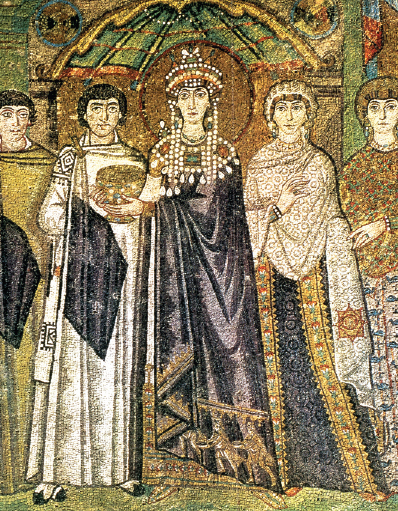Understanding World Societies:
Printed Page 208
INDIVIDUALS IN SOCIETY
Theodora of Constantinople

The most powerful woman in Byzantine history was the daughter of a bear trainer for the circus. Theodora (ca. 497–
Most of our knowledge of Theodora’s early life comes from the Secret History, a tell-
In one of his official histories, The History of the Wars of Justinian, Procopius presents a very different Theodora. Riots between the supporters of two teams in chariot races had turned deadly, and Justinian wavered in his handling of the perpetrators. Both sides turned against the emperor, besieging the palace while Justinian was inside it. Shouting “Nika!” (Victory), the rioters swept through the city, burning and looting. Justinian’s counselors urged flight, but, according to Procopius, Theodora rose and declared:
For one who has reigned, it is intolerable to be an exile. . . . If you wish, O Emperor, to save yourself, there is no difficulty: we have ample funds and there are the ships. Yet reflect whether, when you have once escaped to a place of security, you will not prefer death to safety. I agree with an old saying that the purple [that is, the color worn only by emperors] is a fair winding sheet [to be buried in].
Justinian rallied, ordered more than thirty thousand men and women executed, and crushed the revolt.
Other sources describe or suggest Theodora’s influence on imperial policy. Justinian passed a number of laws that improved the legal status of women, such as allowing women to own property and to be guardians over their own children. He forbade the exposure of unwanted infants, which happened more often to girls than to boys because boys were valued more highly. Theodora presided at imperial receptions for Arab sheiks, Persian ambassadors, Germanic princesses from the West, and barbarian chieftains from southern Russia. When Justinian fell ill from the bubonic plague in 542, Theodora took over his duties. Justinian is reputed to have consulted her every day about all aspects of state policy, including religious policy regarding the doctrinal disputes that continued throughout his reign.
Theodora’s influence over her husband and her power in the Byzantine state continued until she died, perhaps of cancer, twenty years before Justinian. Her influence may have even continued after death, for Justinian continued to pass reforms favoring women and, at the end of his life, accepted an interpretation of Christian doctrine she had favored. Institutions that she established, including hospitals and churches, continued to be reminders of her charity and piety.
Theodora has been viewed as a symbol of the use of beauty and cleverness to attain position and power, and also as a strong and capable co-
QUESTIONS FOR ANALYSIS
- How would you assess the complex legacy of Theodora?
- Since Procopius’s public and private views of the empress are so different, should he be trusted at all as a historical source? Why or why not?

DOCUMENT PROJECT
What do Procopius’s descriptions of Theodora and Justinian tell us about the problems and challenges his society faced? Examine sources that reveal the connections Procopius saw between Byzantium’s rulers and the rapid decline he perceived in Byzantine society, and then complete a quiz and writing assignment based on the evidence and details from this chapter. See Document Project for Chapter 8